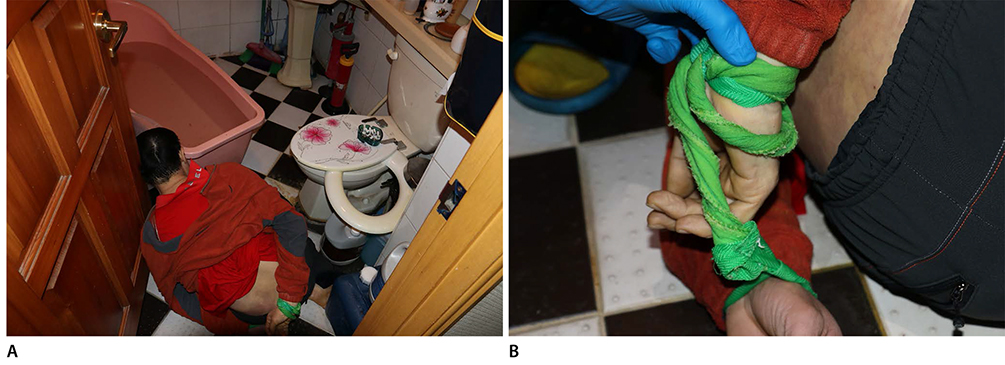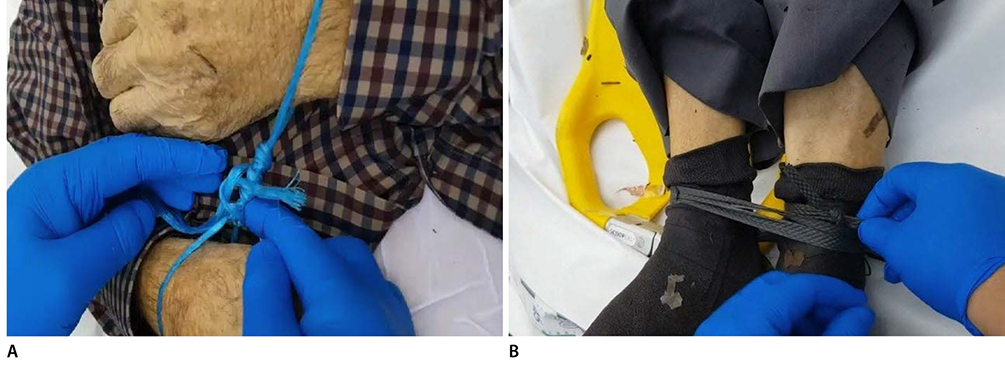Korean J Leg Med.
2017 Aug;41(3):78-82. 10.7580/kjlm.2017.41.3.78.
Drowning with Bound Wrists: Report of Two Autopsy Cases
- Affiliations
-
- 1Department of Pathology, Samsung Medical Center, Sungkyunkwan University School of Medicine, Seoul, Korea.
- 2Busan Metropolitan Police, Busan, Korea.
- 3Division of Forensic Medicine, National Forensic Service Busan Institute, Yangsan, Korea.
- 4Division of Forensic Investigation, National Forensic Service Seoul Institute, Seoul, Korea. sanchee@korea.kr
- KMID: 2389518
- DOI: http://doi.org/10.7580/kjlm.2017.41.3.78
Abstract
- Drowned bodies with bound wrists are occasionally observed in forensic practice. Suicidal victims may bind their hands or feet with a rope to ensure success of the suicide attempt, but the possibility of homicidal drowning cannot be excluded. We report on two autopsy cases of drowning with bound wrists. A 51-year-old man (case 1) was found in the bathroom beside the bathtub, with his head under the water in the bathtub. His wrists were tied with a green bath towel. An 83-year-old man (case 2) was found dead in a reservoir. His wrists were loosely bound with blue nylon traps on the back, and both ankles were loosely tied with socks, with a simple knot on the left ankle. At autopsy, the lungs were hyperinflated, and foamy fluid was exuded from the bronchi in both cases.
MeSH Terms
Figure
Reference
-
1. Statistics Korea. 2015 Causes of death [Internet]. Daejeon: Statistics Korea;2016. [cited 2017 May 1. Available from: http://www.kostat.go.kr.2. Statistics Korea. 2013 Suicide investigation [Internet]. Daejeon: Statistics Korea;2014. cited 2017 May 1. Available from: http://www.kostat.go.kr.3. World Health Organization. Injuries and violence: the fact 2014 [Internet]. Geneva: World Helath Organization;2014. cited 2017 May 1. Available from: http://www.who.int/violence_injury_prevention/other_injury/drowning/en/.4. Ajdacic-Gross V, Weiss MG, Ring M, et al. Method of suicide: international suicide patterns derived from the WHO mortality database. Bull World Health Organ. 2008; 86:726–732.5. Bierens JL. Drowning: prevention, rescue, treatment. 2nd ed. Berlin: Spinger-Verlag;2014.6. Armstrong EJ, Erskine KL. Water-related death investigation: practical methods and forensic applications. Boca Raton: CRC Press;2016.7. Behera C, Karthik K, Singh H, et al. Suicide pact by drowning with bound wrists: a case of medico-legal importance. Med Leg J. 2014; 82:29–31.8. Todt M, Ast F, Wolff-Maras R, et al. Suicide by drowning: a forensic challenge. Forensic Sci Int. 2014; 240:e22-4.9. D'Ovidio C, Rosato E, Carnevale A. An unusual case of murdersuicide: the importance of studying knots. J Forensic Leg Med. 2017; 45:17–20.10. Piette MH, De Letter EA. Drowning: still a difficult autopsy diagnosis. Forensic Sci Int. 2006; 163:1–9.
- Full Text Links
- Actions
-
Cited
- CITED
-
- Close
- Share
- Similar articles
-
- Evaluation of Sodium and Chloride Biochemical Tests in Drowning Autopsy Cases
- The Significance of Fluid in the Sphenoid Sinuses in Death by Drowning
- Shallow Water Blackout (Hypoxic Blackout)–Induced Drowning: An Autopsy Report of Two Cases
- Comparison of Pathologic Findings by Seawater or Fresh Water Drowning on the Experimental Animals
- Analysis of Diatom Detection Result for Immersed Bodies in Honam Area in 2008




